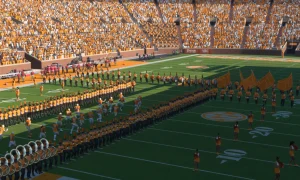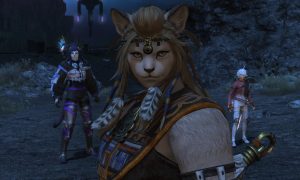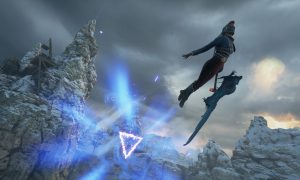
It’s been almost 9 years since we’ve had a slow-motion leaping hero with a permanent look of constipation, but the folks at Rockstar wants to remedy that. The two previous titles were handled by Finnish developer Remedy Entertainment, and they were very well received. They introduced shooters to ‘bullet time’, they took shooters in a mature direction without resorting to just spewing profanity to look ‘gritty’, and the story written by series creator Sam Lake pulled players in with the engrossing story. These are certainly big shoes to fill for Rockstar. To take the game in a new direction, Rockstar brought in Dan Houser, a writer for the Grand Theft Auto series, as well as Red Dead Redemption. Can the producers of the best sandbox titles ever made revive Max Payne, or will we all be making that squinty-face at the end?
Like all the bad things in my life, it started with the death of a woman. I couldn’t save her.
 Surprisingly, Max Payne 3 doesn’t actually start with the death of a woman. Max has turned in his badge and headed to the beautiful São Paulo to work with his long-time friend “Passos” as part of a protection detail. Their employers are one of the most wealthy and powerful families in the country, the types of people that rub elbows with the rich, the powerful, and the criminal. Powerful families with lots of money make juicy targets, and São Paulo’s favelas serve as a clear and ever-present threat. As Max tries to find the end to his pain at the bottom of a glass, armed thugs explode out of the penthouse elevator and nab the debutante and socialite children at gunpoint. On the surface their motivations seem purely financial, but Max soon finds out that this plot runs far deeper than he could have imagined.
Surprisingly, Max Payne 3 doesn’t actually start with the death of a woman. Max has turned in his badge and headed to the beautiful São Paulo to work with his long-time friend “Passos” as part of a protection detail. Their employers are one of the most wealthy and powerful families in the country, the types of people that rub elbows with the rich, the powerful, and the criminal. Powerful families with lots of money make juicy targets, and São Paulo’s favelas serve as a clear and ever-present threat. As Max tries to find the end to his pain at the bottom of a glass, armed thugs explode out of the penthouse elevator and nab the debutante and socialite children at gunpoint. On the surface their motivations seem purely financial, but Max soon finds out that this plot runs far deeper than he could have imagined.
The game takes place several years after the events of the previous titles, but that doesn’t mean that you’ll spend all of your time in São Paulo. Throughout his protection of the Branco family, he’ll face pressures that will push him to spend as much time dodging bullets as he does drinking and taking drugs. Digging back into Max’s past, how he met Passos, and how he ended up protecting the family makes for a great break from the action. As the story unfolds, we see Max in new situations, including even going undercover. What surprised me is just how well paced this title is – I can’t help but think this came courtesy of the release date delay from late 2009 to March of 2012. It isn’t just the gameplay that benefits from the excellent pacing – this favor extends heavily to the gameplay.
Throughout the story you’ll end up in a pretty wide variety of situations. You will do plenty of running and gunning, cover based combat, and slow motion leaping through the air to cut down your opponents. You’ll also get a chance to handle a gun from a helicopter (that doesn’t crash! Is that allowed??), sniping support, handling cover fire from a boat or a vehicle, and much more. If there was any way that Max Payne and Max Payne 2 fell short, it was that it could be repetitive. The folks at Rockstar have handled that nicely, keeping players on their toes with a constantly changing play style.
The new and improved gameplay does come with a few nagging issues, however. There are some very rough save points that leave Max exposed, with low ammo, and with an advancing horde of enemies. These points come in mid-combat  and can make for some frustrating trial and error moments for players. I always play games at Normal or Medium difficulty to review them, and I struggled at some points. Two areas come to mind immediately – the docks and the stadium. On the dock you can throw Max right into the water if you aren’t careful (apparently being Whiskey-soaked doesn’t make you float), so to complete that section (with its very widely spaced save points) I had to completely eschew the shoot-dodge mechanic. On the opposite end, the stadium had me throwing Max down entire flights of stairs to just get any sort of cover. These areas are often punctuated with a mini-boss that carry huge weapons. One particular fight left me exposed in a lobby with only wooden crates as cover. Since the game saved with my back against the crate, I had less than a split second to dodge away as the mini-boss could kill me in a single volley. In the end, it was absolute pure luck and about 15 retries to kill this boss – I stuck him in the eye on accident.
and can make for some frustrating trial and error moments for players. I always play games at Normal or Medium difficulty to review them, and I struggled at some points. Two areas come to mind immediately – the docks and the stadium. On the dock you can throw Max right into the water if you aren’t careful (apparently being Whiskey-soaked doesn’t make you float), so to complete that section (with its very widely spaced save points) I had to completely eschew the shoot-dodge mechanic. On the opposite end, the stadium had me throwing Max down entire flights of stairs to just get any sort of cover. These areas are often punctuated with a mini-boss that carry huge weapons. One particular fight left me exposed in a lobby with only wooden crates as cover. Since the game saved with my back against the crate, I had less than a split second to dodge away as the mini-boss could kill me in a single volley. In the end, it was absolute pure luck and about 15 retries to kill this boss – I stuck him in the eye on accident.
I felt the rise of that old familiar feeling. I hated it. I welcomed it.
While Max Payne has changed engines, mechanics, and even developers, there is one constant – James McCaffrey. McCaffrey returns to the series to voice protagonist Max Payne but there is a bit of a change. In the first two titles, Max was a younger man bent on vengeance for the death of his family. In Max Payne 3, McCaffrey voices a man who is entirely broken. His regrets haven’t faded with time, and Max has fallen so deeply into substance abuse that his nights literally consist of barbiturates and booze binging until he vomits and passes out. Max has nothing left, and he is resigned to his fate. To that end, McCaffrey gives us a character that mixes sarcasm and pain with a sullen realization that he could still do something right in his life when everything else has gone so wrong.
Max Payne was bleeding edge when it was released, and Rockstar is keeping that tradition alive with Max Payne 3. Powered by their own RAGE engine, the game is graphically sharp in motion, but it’s the story cutscenes that caught my eye. Since the game’s loading sequences are hidden completely behind story elements and cutscenes, we get a good look at the cinematics. Dropping the comicbook cutscenes, the game still has a gritty method to convey its content. With some haze and blurring, the scenes unfold using the in-game engine. The important bits are popped up on the screen similar to what you’d see in a more recent graphic novel, punctuating the scene. It works very well and is a welcome upgrade to keep up with the style of more recently released comic styles. It is an excellent way to blur the gameplay and cinematic elements of the game. To add to that immersion, you can’t pick up an entire gun store worth of weapons and carry them – Max can pick up a single-handed weapon like a pistol or Mac-10, and a two-handed weapon like an AR-15 or shotgun. The weapons you are carrying are reflected in the cutscenes – an attention to detail not normally offered by most shooters.
 While the series-staple slow motion jumping is still a big part of the game, being able to fire from cover is new. Using a style similar to what we’ve seen in other shooters, Max can utilize nearly any flat surface to shield himself from the incoming hail of bullets, peeking out to take his shots or using blind fire. Most cover degrades, so staying on the move is the only way to keep yourself from dying of lead poisoning. You can extend this mechanic by combining it with the bullet time mechanic, allowing you to pop out and take a more precise shot. The game does offer three options on how much you’d like to have it help with that auto-aim, including turning it off completely, but the auto-aim mechanic will only give you help aiming to the chest. It isn’t more than a level or two before enemies start showing up with body armor, so you’ll have to get some manual aim practice in sooner or later.
While the series-staple slow motion jumping is still a big part of the game, being able to fire from cover is new. Using a style similar to what we’ve seen in other shooters, Max can utilize nearly any flat surface to shield himself from the incoming hail of bullets, peeking out to take his shots or using blind fire. Most cover degrades, so staying on the move is the only way to keep yourself from dying of lead poisoning. You can extend this mechanic by combining it with the bullet time mechanic, allowing you to pop out and take a more precise shot. The game does offer three options on how much you’d like to have it help with that auto-aim, including turning it off completely, but the auto-aim mechanic will only give you help aiming to the chest. It isn’t more than a level or two before enemies start showing up with body armor, so you’ll have to get some manual aim practice in sooner or later.
Also new to the series is the “Last Man Standing” mechanic. As long as you have a painkiller bottle, if you are wounded fatally you get a last chance to save yourself. Time will slow down and you’ll have whatever is left in your clip to try to kill the person who just shot you. If you succeed, you’ll pop back to life with part of your health, able to soldier on for a bit longer.
The star of this show may be Max, but it is the animation that is the star of this game. Obviously animation is always heavily scrutinized, but when you’ve got the main player leaping through the air in slow motion, it’s even more important. To that end, Rockstar has dedicated over 4000 animations to ensure that Max moves in a natural and realistic way. The result is that both Max and his foes reel from each shot, clutching wounds and being realistically knocked off their feet when appropriate.
The graphical goodness does come at a price. Occasionally you’ll find yourself clipping through objects, occasionally in a fatal way. During the previously-mentioned mini-boss fight I put my back against a vehicle and then promptly clipped through it and got gunned down in a hurry. Similarly, I also slipped through a railing to my death. Thankfully it only happened those two times – it’s not a persistent issue.
I didn’t deserve to walk away. There are no happy endings.
For the first time in the series, Max Payne will get some multiplayer action. The single player game spans about 12 hours of play, but Rockstar wanted to extend that by adding elements of their Social Club. They had the difficult task of somehow integrating the core shooting mechanics into a game with multiple players without having it look completely wrong. Enter “Gang Wars” and “Payne Killer”
Payne Killer mode starts off with a standoff between all players – the first two to score a kill become Max Payne and Passos. Everyone else become gangsters with one job – to kill Max and Passos. When a player kills Max or Passos, they then become them. Think of it as a capture and hold mode.. If you form a social club with the included (if you buy it new) card, you can then maraud through the online landscape as a team – you’ll be automatically matched together.
In addition to the challenge of gunning down your friends, there are also grinds – objectives such as running 26 miles, killing 25 people who are wearing medium body armor, or killing 100 people total. These provide additional XP that can be used to to purchase additional goodies.
While the deathmatch modes are pretty much standard fare (you’ll have to slog through the 8 basic training grinds to unlock anything else), it’s Gang Wars that stands out. Using narrative elements from the single player game, Gang Wars strings together objectives to tell a story, rather than just dropping players into another run-of-the-mill map pack. There are 12 objective types for Gang Wars, supporting up to 16 players. It features a familiar combination of cash and experience mechanics to incent players, asking them to kill a certain amount of players, looting corpses, capturing objectives, and securing VIPs, as example. Short Fuse mode immediately reminded me of Counter Strike (that’s a very good thing), and Siege brought back thoughts of old school capture and hold Unreal.
Naturally, the difficult thing is getting Bullet Time and Shoot-Dodge working with multiple players. Just like it is in single-player, you’ll have to have a certain amount of adrenaline to launch in to these moves, called Bursts. Bullet Time makes all players within sight range move and shoot slower. Breaking line of sight allows them to move in realtime once again, so using the Shoot-Dodge to get behind cover is your best bet. Beyond the Bursts, you can also change up your loadout between 4 class-like presets, with weapons unlocking in a similar way to the Call of Duty series. Similarly, you can unlock and carry up to 5 items – four on your person, and one on your head, such as a helmet. Outside of the item list, you can also snag projectiles like grenades, flashbangs, new custom avatars, and titles via earned XP.
After the round you’ll be able to assess the damage you took and the damage you dealt by looking at paper targets that indicate your accuracy, lifespan, and where exactly you got clipped. It also indicates how much experience you’ll need to get to your next level. You’ll also get a list of what new features you may have unlocked, such as increased loadout weight, new bursts, and additional weapons.
Snagging onto the Social Club aspects of the game, you earn cash that you can then wager during the loading sequences before you play. Earning cash with killstreaks and finishing objectives isn’t the only way to earn cash – simply playing with your Social Club crew nets you extra XP and cash. We’ve seen this sort of thing done before, but it’s not usually this polished – well done Rockstar.
I lied to myself that it was over. I was still alive, my loved ones were still dead. It wasn’t over.
Rockstar took their time with this title, and it shows. Rebuilding not only the universe, but the characters in it, they managed to capture what we loved about the previous titles and matured it for this sequel. The multiplayer is a good addition to the series, enabling players to experience the world Remedy created with the staple bullettime modes intact. Even if you aren’t a fan of multiplayer, there is also enough single-player goodness to make the purchase worthwhile. Rockstar has relaunched this series in a fantastic way – I look forward to seeing what else they wll do with this universe. Welcome back, Max, you pill popping, heavy boozing, self-loathing, slow motion leaping, sociopath – we missed you.
Ron Burke is the Editor in Chief for Gaming Trend. Currently living in Fort Worth, Texas, Ron is an old-school gamer who enjoys CRPGs, action/adventure, platformers, music games, and has recently gotten into tabletop gaming.
Ron is also a fourth degree black belt, with a Master's rank in Matsumura Seito Shōrin-ryū, Moo Duk Kwan Tang Soo Do, Universal Tang Soo Do Alliance, and International Tang Soo Do Federation. He also holds ranks in several other styles in his search to be a well-rounded fighter.
Ron has been married to Gaming Trend Editor, Laura Burke, for 28 years. They have three dogs - Pazuzu (Irish Terrier), Atë, and Calliope (both Australian Kelpie/Pit Bull mixes), and an Axolotl named Dagon!

See below for our list of partners and affiliates:
























